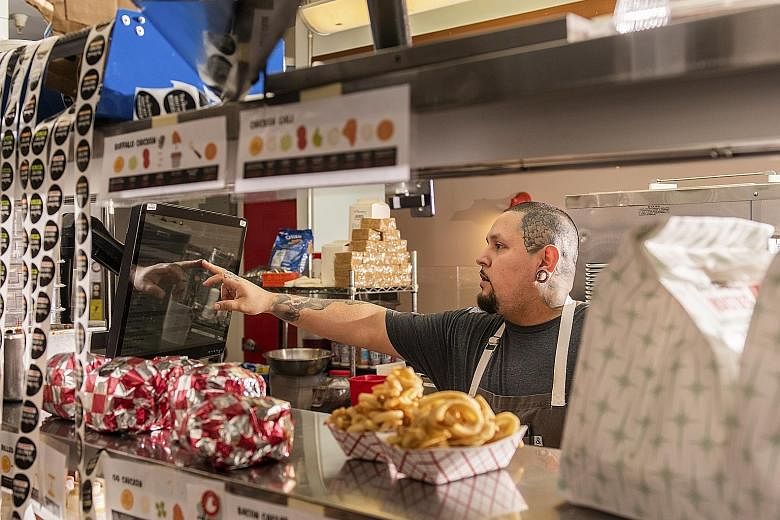SAN FRANCISCO • At 9.30 on most weeknights, Mr Ricky Lopez, head chef and owner of Top Round Roast Beef in San Francisco, stacks up dozens of hot beef sandwiches and sides of curly fries to serve hungry diners.
He also breads chicken cutlets for another of his restaurants, Red Ribbon Fried Chicken.
He flips beef patties on a grill for a third, TR Burgers And Wings. He mixes frozen custard for a dessert shop he runs, Ice Cream Custard.
Of Lopez's four operations, three are "virtual restaurants" with no physical stores, tables or chairs.
They exist only inside a mobile app, Uber Eats, a meal delivery service owned by Uber.
"Delivery used to be maybe a quarter of my business," Lopez, 26, said. "Now it's about 75 per cent."
Food delivery apps like Uber Eats, DoorDash and Grubhub are starting to reshape the American restaurant industry. No longer must restaurateurs rent space for a dining room.
All they need is a kitchen - or even just part of one. The shift has popularised two types of digital culinary establishments.
One is virtual restaurants, which are attached to real-life ones like Lopez's Top Round but make different cuisines specifically for the delivery apps.
The other is "ghost kitchens" which have no retail presence.
"Online ordering is not a necessary evil. It's the most exciting opportunity in the restaurant industry today," said Mr Alex Canter, who runs Canter's Deli in Los Angeles and a start-up that helps restaurants streamline delivery app orders onto one device.
"If you don't use delivery apps, you don't exist."
Many of the delivery-only operations are nascent, but their effect may be far-reaching, potentially accelerating people's turn towards order-in food over restaurant visits and preparing home-cooked meals.
Uber and other companies are driving the change.
Since 2017, the ride-hailing company has helped start 4,000 virtual restaurants that are exclusive to its Uber Eats app.
Ms Janelle Sallenave, who leads Uber Eats in North America, said the company analyses neighbourhood sales data to identify unmet demand for particular cuisines.
It approaches restaurants that use the app and encourages them to create a virtual eatery to tap that demand.
Other companies are also jumping in. Mr Travis Kalanick, the former Uber chief executive, has formed CloudKitchens, a start-up that incubates ghost kitchens.
Yet even as delivery apps create new kinds of restaurants, they are hurting some traditional establishments, which already contend with high operating expenses and brutal competition.
Restaurants that use apps like Uber Eats and Grubhub pay commissions of 15 per cent to as much as 30 per cent on every order.
While digital establishments save on overhead, small independent eateries with narrow profit margins can ill afford those fees.
"There's a concern that it could be a system where restaurant owners are trapped in an unstable, unsuitable business model," Mr Mark Gjonaj, chairman of the New York City Council's small-business committee, said at a four-hour hearing on third-party food delivery in June.
Delivery-only establishments in the United States date to at least 2013, when a start-up, Green Summit Group, began work on a ghost kitchen in New York.
With Grubhub's backing, Green Summit produced food that was marketed online under brand names like Leafage (salads) and Butcher Block (sandwiches).
But Green Summit burnt through hundreds of thousands of dollars a month, said Mr Jason Shapiro, a consultant who worked for the company.
Two years ago, it shut down when it could not attract new investors, he added.
In Europe, food-delivery app Deliveroo also started testing ghost kitchens.
It erected metal kitchen structures called Rooboxes in some unlikely locations, including a derelict parking lot in London.
Last year, Deliveroo opened a ghost kitchen in a warehouse in Paris, where Uber Eats has also tried delivery-only kitchens.
Ghost kitchens have also emerged in China, where online food delivery apps are widely used in the country's densely populated cities.
For Mr Paul Geffner, the growing popularity of food-delivery apps has hurt. He has run Escape From New York Pizza, a small restaurant chain in the Bay Area, for three decades, relying on delivery orders as a major source of revenue.
After he offered delivery through the apps in 2016, his business teetered.
Two of his five pizzerias, which together had generated annual profits of US$50,000 (S$69,400) to US$100,000, lost as much as US$40,000 a year as customers, who had ordered directly from Escape From New York, switched to the apps.
That forced Geffner to pay the commissions.
"We saw a direct correlation between the delivery services and the reduction of our income," he said.
"It was like death by a thousand cuts."
But there are success stories like Mr Lopez's.
"We used to close at 9pm but demand has pushed us to stay open later - we close at 2am now," he said.
NYTIMES

